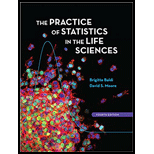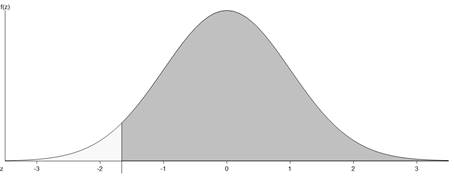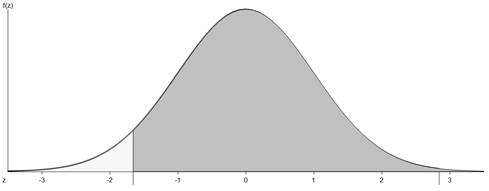
(a)
To use the technology of your choice to find the proportion of observations from a standard
(a)
Answer to Problem 11.8AYK
The proportion of observations for
Explanation of Solution
It is given that we have to use the technology of choice to find the proportion of observations from a standard normal distribution so, we will use excel
Thus, we have to find the probability for
| For z<2.85 | =NORM.S.DIST(2.85,TRUE) |
The result is as:
| For z<2.85 | 0.99781 |
Therefore, the proportion of observations for
And the sketch for the following is as:

(b)
To use the technology of your choice to find the proportion of observations from a standard normal distribution and also sketch a standard normal curve and shade the area.
(b)
Answer to Problem 11.8AYK
The proportion of observations for
Explanation of Solution
It is given that we have to use the technology of choice to find the proportion of observations from a standard normal distribution so, we will use excel function to solve the probability. The function used is as:
Thus, we have to find the probability for
| For z>2.85 | =1-NORM.S.DIST(2.85,TRUE) |
The result is as:
| For z>2.85 | 0.002186 |
Therefore, the proportion of observations for
And the sketch for the following is as:

(c)
To use the technology of your choice to find the proportion of observations from a standard normal distribution and also sketch a standard normal curve and shade the area.
(c)
Answer to Problem 11.8AYK
The proportion of observations for
Explanation of Solution
It is given that we have to use the technology of choice to find the proportion of observations from a standard normal distribution so, we will use excel function to solve the probability. The function used is as:
Thus, we have to find the probability for
| For z>-1.66 | =1-NORM.S.DIST(-1.66,TRUE) |
The result is as:
| For z>-1.66 | 0.95154 |
Therefore, the proportion of observations for
And the sketch for the following is as:

(d)
To use the technology of your choice to find the proportion of observations from a standard normal distribution and also sketch a standard normal curve and shade the area.
(d)
Answer to Problem 11.8AYK
The proportion of observations for
Explanation of Solution
It is given that we have to use the technology of choice to find the proportion of observations from a standard normal distribution so, we will use excel function to solve the probability. The function used is as:
Thus, we have to find the probability for
| For -1.66 | =NORM.S.DIST(2.85,TRUE)-NORM.S.DIST(-1.66,TRUE) |
The result is as:
| For -1.66 | 0.949356 |
Therefore, the proportion of observations for
And the sketch for the following is as:

(e)
To explain in your words why these proportions can also be considered probabilities.
(e)
Explanation of Solution
As we know that these are the probabilities as they satisfy all the three conditions that are:
For any
Probability of
If
Thus, if all the above three conditions are satisfied then these proportions can also be considered probabilities.
Want to see more full solutions like this?
Chapter 11 Solutions
Practice of Statistics in the Life Sciences
 MATLAB: An Introduction with ApplicationsStatisticsISBN:9781119256830Author:Amos GilatPublisher:John Wiley & Sons Inc
MATLAB: An Introduction with ApplicationsStatisticsISBN:9781119256830Author:Amos GilatPublisher:John Wiley & Sons Inc Probability and Statistics for Engineering and th...StatisticsISBN:9781305251809Author:Jay L. DevorePublisher:Cengage Learning
Probability and Statistics for Engineering and th...StatisticsISBN:9781305251809Author:Jay L. DevorePublisher:Cengage Learning Statistics for The Behavioral Sciences (MindTap C...StatisticsISBN:9781305504912Author:Frederick J Gravetter, Larry B. WallnauPublisher:Cengage Learning
Statistics for The Behavioral Sciences (MindTap C...StatisticsISBN:9781305504912Author:Frederick J Gravetter, Larry B. WallnauPublisher:Cengage Learning Elementary Statistics: Picturing the World (7th E...StatisticsISBN:9780134683416Author:Ron Larson, Betsy FarberPublisher:PEARSON
Elementary Statistics: Picturing the World (7th E...StatisticsISBN:9780134683416Author:Ron Larson, Betsy FarberPublisher:PEARSON The Basic Practice of StatisticsStatisticsISBN:9781319042578Author:David S. Moore, William I. Notz, Michael A. FlignerPublisher:W. H. Freeman
The Basic Practice of StatisticsStatisticsISBN:9781319042578Author:David S. Moore, William I. Notz, Michael A. FlignerPublisher:W. H. Freeman Introduction to the Practice of StatisticsStatisticsISBN:9781319013387Author:David S. Moore, George P. McCabe, Bruce A. CraigPublisher:W. H. Freeman
Introduction to the Practice of StatisticsStatisticsISBN:9781319013387Author:David S. Moore, George P. McCabe, Bruce A. CraigPublisher:W. H. Freeman





